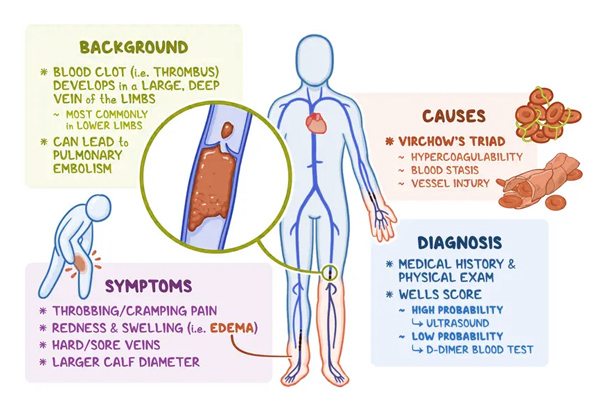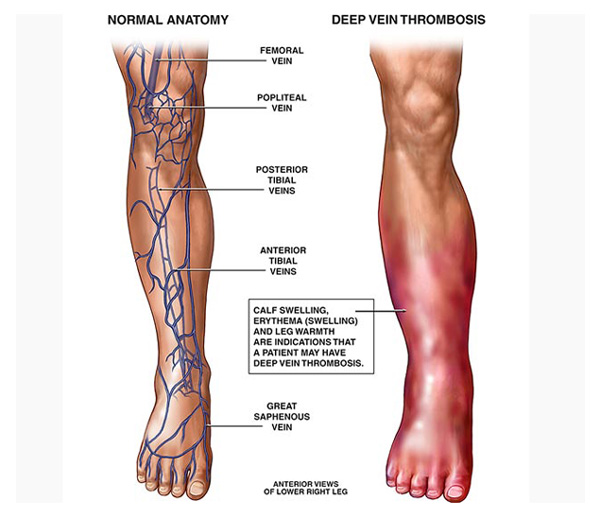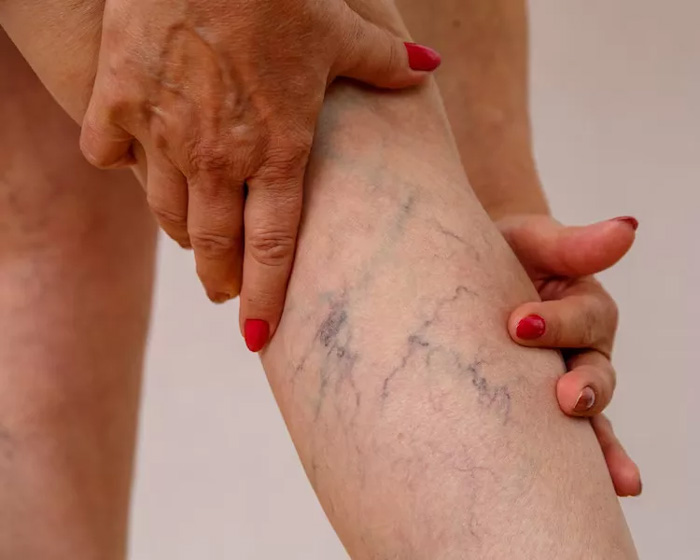What is Deep Vein Thrombosis (DVT)?
Deep Vein Thrombosis (DVT) is a condition where a blood clot forms in deep veins, usually in the legs. These clots can block blood flow, leading to swelling, pain, and other serious complications. If left untreated, a clot can travel to the lungs, causing a life-threatening condition known as pulmonary embolism (PE).
Why Do Blood Clots Form in the Veins?
Blood clot formation happens when blood flow slows down or becomes stagnant, often due to prolonged inactivity, certain medical conditions, or genetic factors. Some common causes include:
- Long hours of sitting or lying down
- Surgery or injury to the veins
- Certain medical conditions, such as vascular disease or clotting disorders
- Pregnancy, obesity, or smoking
Importance of Early Diagnosis in Preventing Serious Complications
Detecting DVT early can help prevent severe complications like pulmonary embolism. Symptoms such as leg swelling, pain, and discomfort should not be ignored.
Seeking DVT Treatment in Mumbai at a specialized blood clot in leg treatment clinic can ensure timely diagnosis and care.
A DVT doctor will assess the condition through tests and recommend appropriate treatments, including medications, lifestyle changes, and medical procedures to prevent clot movement and further complications.

Symptoms of Deep Vein Thrombosis (DVT)
How to Identify Deep Vein Thrombosis Symptoms Early
Recognizing deep vein thrombosis symptoms in the early stages is essential to prevent severe complications.
DVT usually affects the legs, causing discomfort and visible changes. While some individuals may not experience noticeable symptoms, common warning signs include:
- Swelling in one leg: Sudden or gradual swelling, typically in the lower leg or thigh.
- Leg pain or tenderness: A dull or sharp pain that worsens while standing or walking.
- Skin discoloration: The affected area may turn red, blue, or develop a darker tone.
- Warmth and inflammation: The skin over the clot may feel warmer compared to the surrounding areas.
When Should You See a DVT Specialist Doctor Near You?
If you notice persistent leg swelling, pain, or unexplained discomfort, it is crucial to consult a DVT doctor near me. Ignoring these symptoms can lead to serious health risks, including pulmonary embolism, which occurs when a blood clot travels to the lungs. Seeking medical advice promptly can prevent life-threatening complications.
Difference Between DVT Symptoms and Muscle Cramps
Many people mistake DVT symptoms for muscle cramps. However, key differences help distinguish between the two:
Feature | DVT Symptoms | Muscle Cramps |
Pain Pattern | Persistent, often worsening with movement | Temporary, relieved by stretching |
Swelling | Typically affects one leg, with noticeable inflammation | Usually no swelling |
Skin Changes | Red or bluish discoloration, warm to touch | No skin color changes |
Duration | Symptoms last for days or weeks | Lasts a few seconds to minutes |
If you are unsure how to check for a blood clot in your leg, a medical evaluation, including ultrasound imaging and blood tests, can confirm the condition.
What Causes DVT?
Understanding Why Some People Are More Prone to Deep Vein Thrombosis
DVT full form in medical is Deep Vein Thrombosis, a condition where a blood clot forms in a deep vein, usually in the legs. Certain factors increase the risk of developing DVT, making early awareness and preventive measures crucial.
Common Risk Factors for DVT
Several factors can lead to DVT, including:
- Immobility: Prolonged bed rest, long flights, or sitting for extended periods can slow blood circulation.
- Surgery or Injury: Medical procedures, especially those involving the legs or abdomen, can damage veins, leading to clot formation.
- Obesity: Excess weight puts pressure on veins, affecting blood flow.
- Smoking: Chemicals in tobacco can damage blood vessels, making clotting more likely.
Why Are Cancer Patients and Pregnant Women at Higher Risk?
Certain conditions increase DVT risk, particularly:
- Cancer Patients: Some types of cancer and their treatments can cause blood to clot more easily. Chemotherapy, radiation, and long periods of inactivity contribute to this risk.
- Deep Vein Thrombosis Pregnancy Risks: Pregnancy alters blood composition, increasing clotting factors. Additionally, pressure from the growing uterus can restrict blood flow in the legs, making DVT more likely.
Lifestyle Habits That Increase the Risk of Blood Clots
Certain habits can further contribute to DVT risk:
- Prolonged travel: Sitting for long hours without movement reduces circulation.
- Dehydration: Thickens the blood, increasing clot formation risks.
- Lack of exercise: A sedentary lifestyle reduces blood flow efficiency.
Wearing compression stockings, staying active, and maintaining a healthy lifestyle can lower the chances of developing DVT. If you are at risk, consulting a medical professional can help with early detection and prevention.
Diagnosis – How is DVT Identified?
DVT Test Methods for Early Detection
Detecting Deep Vein Thrombosis (DVT) early is crucial in preventing complications. A DVT test helps confirm whether a blood clot is present in the deep veins. Doctors use multiple diagnostic tools to evaluate vein blockages and clot markers for accurate detection.
How Does a Thrombosis Test Work?
A thrombosis test involves different procedures based on symptoms and risk factors. Common methods include:
- Ultrasound Imaging: A non-invasive test that detects clot formation using sound waves.
- D-Dimer Blood Test: Measures a protein fragment in the blood released when a clot breaks down. High levels suggest possible DVT.
- Venography: Uses contrast dye injected into a vein to highlight blockages in X-ray imaging.
- MRI or CT Scan: Provides a detailed view of deep veins, especially when ultrasound results are inconclusive.
When Should You Visit a DVT Specialist Doctor for a Blood Test for Blood Clots?
If you experience persistent leg swelling, unexplained pain, or sudden redness, it is recommended to consult a DVT doctor near me. A blood test for blood clots combined with imaging scans helps in confirming DVT and preventing further complications.
Seeking medical attention at the right time ensures early diagnosis and treatment, reducing the risks of pulmonary embolism and long-term vein damage. If you suspect DVT, visiting a healthcare provider for evaluation is the safest option.
Treatment Options for DVT
How is Deep Vein Thrombosis Treated?
The treatment for Deep Vein Thrombosis (DVT) focuses on preventing clot growth, reducing complications, and restoring normal blood flow. Depending on the severity of the condition, doctors may recommend medications, lifestyle modifications, or surgical procedures.
DVT Medication: Blood Thinners and Anticoagulants
The most common approach to treating DVT involves anticoagulant medications that help prevent existing clots from getting larger and reduce the risk of new clots forming. These include:
- Heparin: A fast-acting injectable blood thinner used in hospitals.
- Warfarin: An oral anticoagulant that requires regular blood tests to monitor dosage.
- Direct Oral Anticoagulants (DOACs): Medications like rivaroxaban and apixaban, which do not require frequent monitoring.
These medications do not dissolve existing clots, but they allow the body to gradually break them down over time.
DVT Treatment and Exercise: Safe Rehabilitation Practices
Exercise plays a role in improving circulation and preventing further clot formation. However, patients should follow safe and controlled movement routines:
- Walking regularly: Short, frequent walks help improve blood flow.
- Leg elevation: Keeping the legs raised while resting reduces swelling.
- Compression stockings: Help prevent vein inflammation and clot progression.
- Avoid prolonged sitting or standing: Movement every hour is recommended.
A healthcare provider can recommend DVT treatment and exercise routines based on individual health conditions.
Surgical Management of DVT: When is Surgery Needed?
Surgery is considered for severe cases of DVT where medication alone is not effective. DVT surgical treatment options include:
- Thrombolysis: A catheter-based technique where clot-dissolving drugs are injected directly into the vein.
- Surgical Clot Removal: A vascular surgeon removes the clot manually in high-risk cases.
- Inferior Vena Cava (IVC) Filter: A small device inserted into the main vein to prevent clots from reaching the lungs.
These procedures are usually performed in patients with severe blockages, complications, or those who cannot take anticoagulant medications.
Getting the right DVT treatment at the right time prevents long-term complications like post-thrombotic syndrome. A medical professional can recommend the best approach based on individual risk factors and overall health condition.
Prevention of DVT – How to Lower the Risk
Steps to Reduce the Risk of Developing Blood Clots
Preventing Deep Vein Thrombosis (DVT) requires lifestyle changes and proactive strategies to support healthy blood circulation. While some risk factors, such as genetics or medical conditions, cannot be changed, there are many ways to reduce the chances of clot formation.
Lifestyle Changes That Help Prevent DVT
Making small changes to daily habits can significantly lower the risk of blood clots:
- Stay Active: Regular movement prevents blood from pooling in the veins. Simple activities like walking, stretching, or standing up frequently can make a difference.
- Maintain a Healthy Weight: Extra weight increases pressure on the veins, slowing down circulation.
- Avoid Prolonged Sitting or Standing: Taking walking breaks during long flights, road trips, or office hours keeps blood flowing.
- Stay Hydrated: Drinking enough water prevents blood from thickening, reducing clot risk.
How Compression Stockings Improve Circulation
Wearing compression stockings is a medically recommended method for DVT management. These specially designed stockings:
- Apply gentle pressure to the legs, improving blood circulation.
- Reduce swelling and discomfort, particularly for individuals prone to blood clot formation.
- Help prevent post-thrombotic syndrome, a condition that causes long-term leg pain and swelling after DVT treatment.
Doctors often recommend compression stockings for people recovering from DVT, frequent travelers, and those who remain sedentary for long periods.
DVT Management Strategies After Treatment
Even after successful DVT treatment, ongoing care is essential to prevent recurrence. Key strategies include:
- Regular Follow-Ups: Seeing a doctor for check-ups ensures early detection of any complications.
- Medications as Prescribed: If anticoagulants are prescribed, taking them consistently reduces clotting risks.
- Gradual Return to Physical Activity: Light exercises like walking and stretching improve circulation without straining the veins.
Implementing these strategies helps reduce the likelihood of DVT recurrence and supports long-term vein health. Seeking guidance from a healthcare provider can help create a personalized prevention plan based on individual risk factors.
FAQ
Q1) What is the full form of DVT in medical terms?
Answer- The DVT full form in medical is Deep Vein Thrombosis. It refers to a condition where a blood clot forms in a deep vein, usually in the legs.
Q2) How can DVT be cured?
Answer- The treatment for DVT depends on the severity of the condition. In most cases, it is managed with anticoagulants (blood thinners), compression stockings, and lifestyle modifications. In more serious cases, a DVT doctor may recommend thrombolytic therapy or surgical interventions to remove the clot.
Q3)What are the first signs of a blood clot in the leg?
Answer- The most common signs of DVT include:
- Swelling in one leg
- Pain or tenderness, especially when walking
- Red or bluish skin discoloration
- Warmth over the affected area
If these symptoms appear suddenly, immediate medical attention is necessary to prevent complications.
Q4) Which doctor should I consult for DVT?
Answer- A vascular specialist or hematologist is usually the right choice for diagnosing and treating DVT. If you are searching for a DVT doctor, consulting a specialist early can help prevent further complications.
Q5) What are the latest treatments for DVT?
Answer- Modern DVT treatment options include:
- Direct oral anticoagulants (DOACs) – A newer class of blood thinners with fewer side effects.
- Catheter-Directed Thrombolysis – A minimally invasive procedure to dissolve large clots.
- Inferior Vena Cava (IVC) Filter – Used for patients who cannot take blood thinners.
Q6) Is DVT treatment available in Vasai and Virar?
Answer- Yes, DVT treatment in Vasai and DVT treatment in Virar is available at specialized medical centers. It is recommended to seek care from qualified DVT specialists in these locations.
Q7) How do doctors check for blood clots?
Answer- Doctors use various diagnostic tests, including:
- Ultrasound – The most common test to detect DVT.
- D-Dimer Blood Test – Measures clot-dissolving substances in the blood.
- Venography and MRI – Used in complex cases for a detailed vein analysis.
Q8) Can DVT be treated without surgery?
Answer- Yes, in most cases, DVT treatment does not require surgery. Blood thinners, compression therapy, and lifestyle adjustments are usually enough to manage the condition. Surgery is only considered for severe or life-threatening cases.
Q9) Are blood thinners safe for treating DVT?
Answer- Blood thinners are generally safe but may increase the risk of bleeding. Regular monitoring and medical supervision help minimize side effects while ensuring effective DVT management.
Q10)Can exercise help dissolve a blood clot?
Answer- Exercise does not directly dissolve a clot, but regular movement improves blood circulation and reduces clot progression. Safe activities such as walking and light stretching are recommended after a doctor’s approval.
Get Expert DVT Treatment in Mumbai
If you are experiencing symptoms of Deep Vein Thrombosis (DVT), seeking timely medical care can prevent serious complications. Our team of DVT specialists provides advanced diagnosis and treatment options tailored to each patient’s needs.
Whether you need medication-based therapy, surgical intervention, or lifestyle guidance, our experts will ensure the best care for your condition. If you are looking for the best DVT treatment in Mumbai, we are here to help.
Book an Appointment Today
Don’t delay your treatment. Consult a DVT Treatment doctor in Mumbai today for expert evaluation and care. Contact us now to schedule your consultation and take the first step toward better vascular health.
Our Services
X-Ray | Sonography | Prostate Artery Embolization In Vasai | Deep Vein Thrombosis Specialists | Peripheral Artery Disease Specialist | Best Diagnostic Center In Vasai








